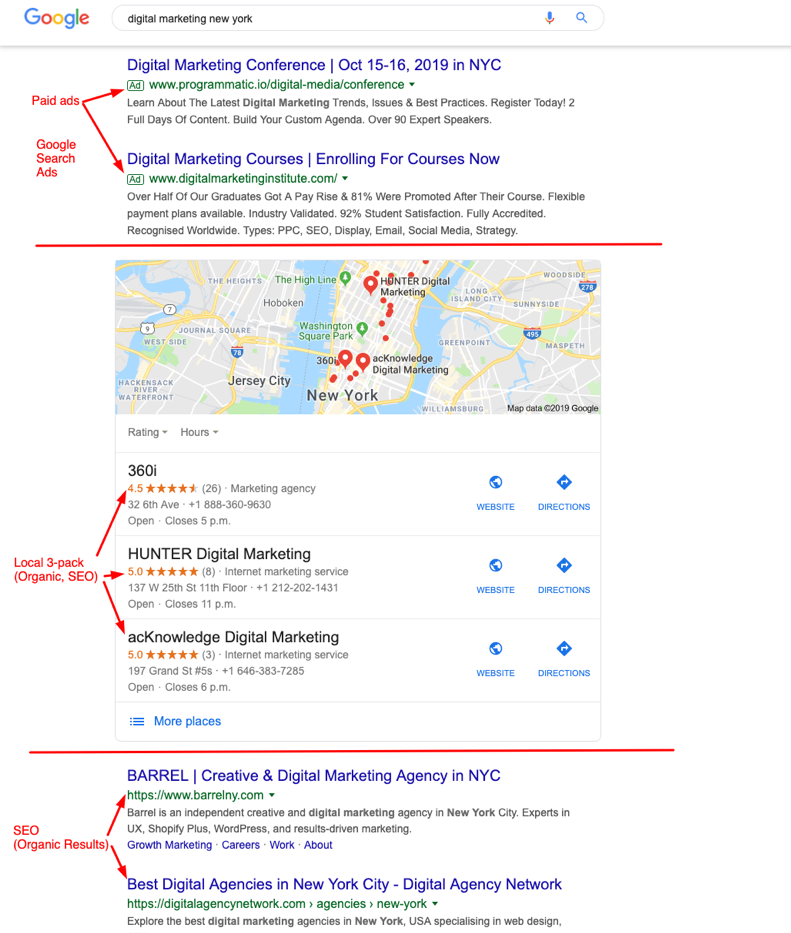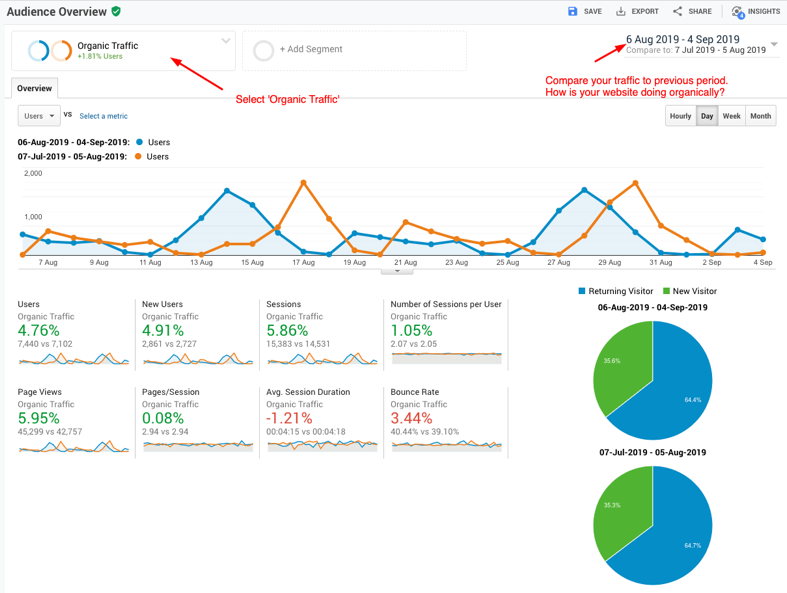Organic vs. Paid Ads: What Strategy Is Best For Your Business?
The Google Search Results Page (a.k.a SERP page) contains results that the search engine returns to your search query. SERP might contain organic results only, or a mix of paid and organic results. The paid-to-organic ratio is ever changing and can reach up to 50/50.
Whatever the proportion, you will be able to unequivocally tell paid from organic results by just looking at search results – ads will have the word ‘Ad’ next to it – all paid ads are marked as such. Here is how it looks on the actual SERP page:

Paid vs. Organic Results on the SERP page
The top positions that are marked as ‘Ad’ and are secured through Google Search Ads. Then the so-called ‘Local 3-pack’ follows, i.e. a list of local businesses, who are added and verified through Google My Business and are therefore showing on the map. Finally, there are organic results – this is where all the websites aim to be.
What is Google Ads?
As outlined before, Google Ads is a Google-owned advertising platform. Ads can appear as text, banners, videos or a combination thereof. Ad format and advertising channels depend on business and marketing goals, so it’s always a good idea to do initial research and decide which is right for your business.
For example, display advertising might be good for reach and/or brand awareness of your business, while search campaigns might be effective for traffic/conversions.
With Google ads you pay either when users click on your ad (CPC model) or when users see a certain number of impressions (CPM model). Competition on Google is as high as ever, and depending on the niche, cost per click (CPC) can range from $0.6 to $50-$100 and there actually is no upper limit! That being said, when considering Google Ads, you really need to do your basic math and be very specific about your business and marketing goals.
Luckily, Google has built an extensive network of partners and your ads can be shown across a variety of platforms and Google products, e.g. Google Play, Google Shopping, Google Images, Google Maps. Such an extensive ecosystem allows digital marketers to attain virtually any business objective.
The Google Ads platform utilizes automated ad auctions to determine positions on the SERP. An ad auction is a rather sophisticated system that takes into account a plethora of factors, e.g. CTR, keyword relevance, landing page quality, ad relevance – to name a few. Google advertisers need to be 100% sure what they are doing with your ads and your ad dollars. It is therefore important that your Google Ads are run by certified professionals, who are qualified to work with the Google Ads ecosystem and can generate decent amount of traffic to your website.
Question: Do you know why PPC managers can’t drive to work?
Answer: Because they generate so much traffic.
What is SEO?
Search engine optimization (SEO) is the process of driving organic traffic to one’s website. The key difference here is the word ‘organic’ or in other words – unpaid. It might sound easy, however it’s a long and complicated process that involves lots of keyword research, organization, content planning & writing, website technical optimization, internal linking, backlink strategy and many other variables. As a cherry on top, Google is constantly updating their algorithms, making tweaks on virtually a daily basis. (Source: https://webmasters.googleblog.com/2019/08/core-updates.html)
Take all these factors into account and you will see that driving organic traffic to your website is not as easy as it seems at a glance. Still, webmasters are left with no choice other than try to outperform their competition and get as high as possible on the SERP, or at least to get their results to show on first page of Google results.
The higher your keywords rank, the more clicks and traffic you are likely to collect. Should your page end up on the second page of Google SERP, your site will take a nosedive in traffic. After all, there’s a reason this SEO joke never gets old:
Question: What is the safest place to hide a body?
Answer: The second page of Google…
The key component of generating organic traffic to your website is original, engaging content that is useful and valuable to your audience. It can’t be otherwise nowadays – the competition is just too high.
So how do I make it to the top?
The answer is both simple and complicated at the same time. To rank high organically, you will need to take care of the following processes:
- Develop overall content strategy
- Perform keyword research
- Write original, engaging and useful content
- Create quality and engaging images or high-quality infographics
- Analyze web traffic consistently
- Analyze and optimize your website and its conversion rates
This can be taken care of by different people or one specialist, but rule of thumb remains the same – to achieve high rankings, you will need to show commitment, determination, persistence and hard work. If you take a high-level look at these processes, you will notice it’s very similar to developing an offline business – you need to stay in business to gain visibility, earn trust, show excellent customer service, and generate some buzz and partnerships.
Google Ads vs. Organic Search
To make things a bit easier, here is a comparative table of the two main tools from the business prospective:
| Google Ads (Paid Traffic) | SEO (Organic Traffic) | |
| Money | Paid | Free |
| Time Effect | Short-Term | Long-Term |
| Results | Immediate | Extended Over Time |
| Measurability | Easier to Measure | Harder to Measure |
- Money. Amount of paid traffic is limited by your advertising budget. The share of paid traffic on Google is a lot smaller than organic traffic, so your SEO has definitely a lot more potential than running ads on Google. While there is no one-size-fits-all solution, for most businesses a healthy long-term ratio in paid vs. organic would be 20/80.
- Time effect. With Google ads, once ads are set up, all it takes is up to 24 hours to get approval and off you go. This makes paid ads almost instant in their impact. SEO takes a lot longer to kick in. The general rule of thumb we use internally is: any SEO changes that you make to your website today, will start showing within 60 days. That being said, for new businesses, Google Ads makes most sense for immediate results. Of course, SEO shouldn’t be neglected, and you should see starting results within a couple of months from the start.
- Results. With Google Ads, your results will be virtually immediate – once a user clicks on the ad, the click and the visit are recorded in analytics and stored indefinitely. You can track impressions, clicks, conversions – virtually everything you need to make informed decisions. With SEO, it’s harder because what you’re doing today most likely won’t have an immediate impact.
- Measurability. Google Ads allow you to easily measure the amount of money you spend on ads and compare it against your advertising goals. With SEO, it’s a little more complicated because all SEO expenses are spread out between a number of activities (copywriting, design, coding etc), making it all a lot harder to measure. In addition, impact of SEO activities can have a delayed impact, be stretched over time, or even might not have any impact at all. All of it makes it very hard to directly compare against paid advertising, should you ever question which of the two you should focus on.
Even so, organic traffic has so much potential that it’s worth doing by default. Over time you will probably see that as your brand becomes more recognized, your users will search the Web by your company name and other keywords will follow suit over time. It’s good practice to keep track of your organic traffic, so why don’t we do a quick check?
What’s your organic traffic like?
Do you know what your organic traffic is? Would you like to find out now?
Go to Google Analytics -> Overview (see Fig 2). Pick ‘Organic Traffic’ segment and filter your traffic to see organic results only. Feel free to play with it and compare it to previous periods (week, month or year). How is your website doing organically?

How to check your organic traffic flow
Paid or Organic Traffic: Which is Right For My Business?
That’s a great question! As a matter of fact, every business owner is asking it when it comes to digital marketing. To provide a better response, we need to rephase the question a bit, and tackle it from a different perspective:
‘When is it best to use paid ads? When should I focus on SEO more?’
That’s even a better question! First, SEO and Google Ads are not mutually exclusive as they easily complement each other.
Google Ads is best for:
- Start-ups or new businesses who need quick results
- Testing out or validating customer demand for new services and products
- Building brand awareness and reach
- Generating traffic and conversions in addition to your organic traffic
Search Engine Optimization is best for:
- All types of businesses, looking to increase digital presence
- Getting long-term, consistent traffic
- Minimizing customer acquisition cost
- Maximizing conversions
Bottom line is – focusing your efforts on long-term, strategic SEO marketing is a great starting point and is probably your best bet if you have a limited budget. With proper content marketing, through social media as amplifier to your message, you have the potential of reaching a lot more audience. Paid advertising is an optimal solution when you need trackable short-term traffic that you can specifically link to goals in Google Analytics (ie. click to call, fill out a form, etc).
Conclusion
- Google Ads is a perfect solution for measuring exact results.
- Google Ads is highly recommended for new businesses and start-ups since it allows to you to quickly get traffic and customers.
- Google Ads is a sophisticated ecosystem and it’s highly recommended to use services by Google Ads certified professionals only.
- Google Ads and SEO complement each other and should be used in conjunction.
- SEO is a long-term process and requires constant work.
- SEO is required for all websites to achieve optimal results. You may opt out of running ads but neglecting SEO will have detrimental consequences for your website traffic.
Do you need help with driving more traffic to your website? TRUEdotDESIGN is a full-service marketing agency, specializing in design, branding, strategic marketing as well as driving paid and organic traffic for your website. Our staff is Google Ads and Facebook Blueprint Certified. Contact us for a discovery call today!
